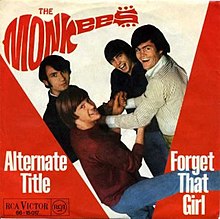
About the song
The Monkees have long been celebrated for their catchy pop hits and television charm, but one of their standout tracks, “Randy Scouse Git,” showcases a deeper, more experimental side of the band. Released in 1967, this song was part of their third album, “Headquarters,” and it stands out not only for its unique title but also for its blend of insightful lyrics and innovative musical arrangements.
“Randy Scouse Git” was written by Micky Dolenz, the drummer and one of the vocalists for The Monkees. The song’s title, which is British slang for a “lecherous, loudmouthed youth,” was inspired by an episode of the popular British sitcom “Till Death Us Do Part”. In the United Kingdom, the song was released under the title “Alternate Title” due to concerns about the potentially offensive nature of its original name. This decision underscores the cultural impact and sensitivity of the era, highlighting the differing sensibilities between American and British audiences.
The song was released in the summer of 1967, during a period of significant cultural and social upheaval. The Summer of Love was in full swing, and music was a powerful vehicle for expressing the changing attitudes and values of the younger generation. “Randy Scouse Git” reflects this era’s spirit with its unconventional structure and eclectic influences, blending elements of rock, pop, and psychedelia.
Lyrically, “Randy Scouse Git” captures a moment in time for The Monkees and Micky Dolenz personally. The song references various events and people from Dolenz’s life, including his experiences in London and the media frenzy surrounding the band. Lines like “She’s a wonderful lady, and she’s mine all mine” are thought to refer to his then-girlfriend Samantha Juste, while the chaotic imagery and rapid-fire delivery mirror the whirlwind lifestyle of a rock star in the 1960s.
Musically, the song is a departure from the typical Monkees sound. It features a dynamic and unconventional arrangement, with Dolenz playing the timpani and a distinctive piano riff driving the melody. The song’s eclectic style and innovative production techniques were a bold move for the band, who were striving to be taken seriously as musicians and break free from their “manufactured” image.
“Headquarters,” the album featuring “Randy Scouse Git,” was a significant milestone for The Monkees. It was the first album where the band members had creative control and played their own instruments, marking a turning point in their career. The success of “Headquarters” and the innovative tracks like “Randy Scouse Git” demonstrated their artistic capabilities and helped to establish them as legitimate musicians in the eyes of critics and fans alike.
“Randy Scouse Git” remains a testament to The Monkees’ versatility and willingness to push boundaries. Its fusion of personal reflection, cultural commentary, and musical experimentation makes it a standout track that continues to resonate with listeners. For fans of The Monkees and music historians, the song is a fascinating glimpse into the band’s evolution and the broader cultural landscape of the 1960s.
In conclusion, “Randy Scouse Git” is more than just a song—it’s a cultural artifact that encapsulates the era’s spirit and The Monkees’ artistic journey. Whether you’re revisiting it for nostalgia or discovering it for the first time, the song’s innovative sound and evocative lyrics are sure to leave a lasting impression.
Video
Lyrics
She’s a wonderful lady
And she’s mine all mine
And there doesn’t seem a way
That she won’t come and lose my mind.
It’s too easy humming songs
To a girl in yellow dress
It’s been a long time since the party
And the room is in a mess.The four kings of E.M.I.
Are sitting stately on the floor
There are birds out on the sidewalk
And a valet at the door.
He reminds me of a penguin
With few and plastered hair,
There’s talcum powder on the letter
And the birthday boy is there.Why don’t you cut your hair?
Why don’t you live up there?
Why don’t you do what I do,
See what I feel when I care?Now they’ve darkened all the windows
And the seats are naugh-a-hyde.
I’ve been waiting for an hour,
I can’t find a place to hide.
The being known as Wonder Girl
Is speaking I believe.
It’s not easy tryin’ to tell her
That I shortly have to leave.Why don’t you be like me?
Why don’t you stop and see?
Why don’t you hate who I hate,
Kill who I kill to be free.[Progressive scat vocals]
Why don’t you cut your hair?
Why don’t you live up there?
Why don’t you do what I do,
See what I feel when I care?
Why don’t you be like me?
Why don’t you stop and see?
Why don’t you hate who I hate,
Kill who I kill to be free.